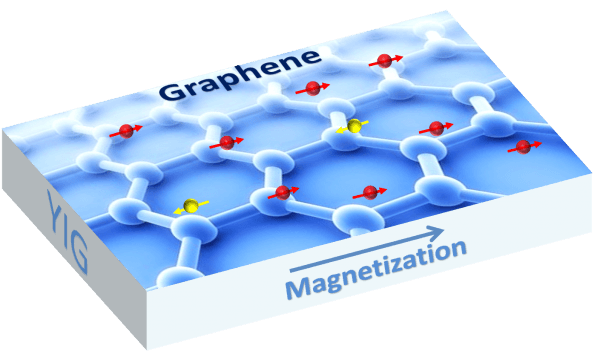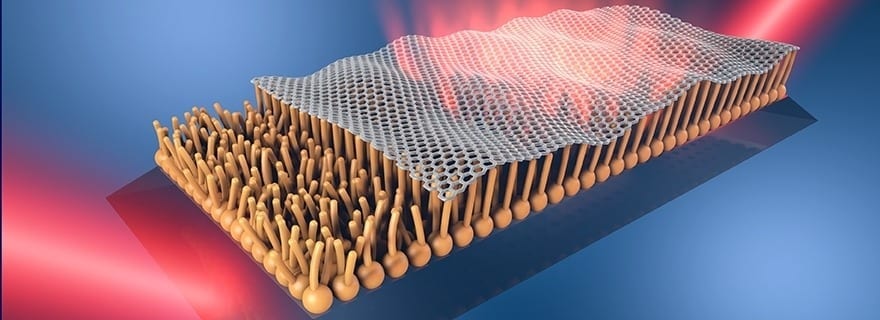
IMAGE CREDIT: SHI LAB, UC RIVERSIDE.
UC Riverside research could lead to new multi-functional electronic devices
Graphene, a one-atom thick sheet of carbon atoms arranged in a hexagonal lattice, has many desirable properties. Magnetism alas is not one of them. Magnetism can be induced in graphene by doping it with magnetic impurities, but this doping tends to disrupt graphene’s electronic properties.
Now a team of physicists at the University of California, Riverside has found an ingenious way to induce magnetism in graphene while also preserving graphene’s electronic properties. They have accomplished this by bringing a graphene sheet very close to a magnetic insulator – an electrical insulator with magnetic properties.
“This is the first time that graphene has been made magnetic this way,” said Jing Shi, a professor of physics and astronomy, whose lab led the research. “The magnetic graphene acquires new electronic properties so that new quantum phenomena can arise. These properties can lead to new electronic devices that are more robust and multi-functional.”
The finding has the potential to increase graphene’s use in computers, as in computer chips that use electronic spin to store data.
Study results appeared online earlier this month in Physical Review Letters.
The magnetic insulator Shi and his team used was yttrium iron garnet grown by laser molecular beam epitaxy in his lab. The researchers placed a single-layer graphene sheet on an atomically smooth layer of yttrium iron garnet. They found that yttrium iron garnet magnetized the graphene sheet. In other words, graphene simply borrows the magnetic properties from yttrium iron garnet.
Magnetic substances like iron tend to interfere with graphene’s electrical conduction. The researchers avoided those substances and chose yttrium iron garnet because they knew it worked as an electric insulator, which meant that it would not disrupt graphene’s electrical transport properties. By not doping the graphene sheet but simply placing it on the layer of yttrium iron garnet, they ensured that graphene’s excellent electrical transport properties remained unchanged.
Read more: Researchers Make Magnetic Graphene
The Latest on: Magnetic Graphene
[google_news title=”” keyword=”Magnetic Graphene” num_posts=”10″ blurb_length=”0″ show_thumb=”left”]
via Google News
The Latest on: Magnetic Graphene
- Graphene at 20: why the ‘wonder material’ is finally coming goodon April 30, 2024 at 6:31 am
Strong, light and with amazing electronic properties, graphene has always been touted as the “wonder material”. But two decades after it was first isolated, James McKenzie believes the graphene is ...
- Photons Frozen in Time by Innovative Crystal Designson April 29, 2024 at 9:13 am
AMOLF researchers, in collaboration with Delft University of Technology, succeeded in bringing light waves to a halt by deforming the two-dimensional photonic crystal that contains them. The ...
- Revolutionizing Technology: Spintronics Market Surges, Expected to Reach US$ 1.4 Billion by 2033on April 29, 2024 at 5:18 am
Spintronics Market is set to cross worth of US$ 1,394.2 Million at 7.3% CAGR during forecast period 2023 to 2033 | Data analysis by Future Market Insights, Inc.
- Quantum leap: Scientists make light waves "stand still"on April 28, 2024 at 9:16 am
Scientists have discovered a novel method to manipulate light waves, using nanophotonics, deforming the photonic crystal that contains them.
- Quantum Breakthrough: Researchers Unlock New Realms in 1D Superconductivityon April 27, 2024 at 7:14 am
Researchers at the University of Manchester have made a major advancement in superconductivity by successfully maintaining robust superconductivity under high magnetic fields in a new one-dimensional ...
- The Flash Pro Plus gives you a power supply anywhere for only $199.97on April 27, 2024 at 7:00 am
This impressive magnetic wireless charging can power up ... Powered by Panasonic™, the Flash Pro Plus has a graphene battery and massive capacity of 25,000mAh of power. You can charge your ...
- Manchester Scientists Find Novel One-Dimensional Superconductoron April 25, 2024 at 1:31 am
In a significant development in the field of superconductivity, researchers at The University of Manchester have successfully achieved robust superconductivity in high magnetic fields using a newly ...
- Mechanical strain control of quantum transport in graphene enables new class of nanoelectronic deviceson April 23, 2024 at 5:00 pm
The concept of generating vector potentials equivalent to magnetic fields through mechanical strain was first proposed theoretically for graphene in 2010. The theory predicted phenomena like ...
- Condensed matter physics: Novel one-dimensional superconductoron April 23, 2024 at 5:00 pm
In a significant development in the field of superconductivity, researchers have successfully achieved robust superconductivity in high magnetic fields using a newly created one-dimensional (1D) ...
- Magnetic with a pinch of hydrogenon April 21, 2024 at 5:00 pm
Magnetic two-dimensional materials consisting ... thereby isolating single-layer carbon, so-called graphene. The simple trick worked because the individual layers of graphite are only loosely ...
via Bing News










